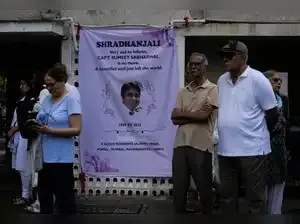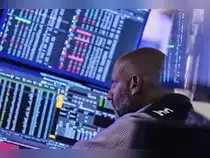A preliminary report depicted confusion in the cockpit shortly before an Air India jetliner crashed, killing 260 people last month, after the plane's engine fuel cutoff switches almost simultaneously flipped, starving the engines of fuel.
The Boeing 787 Dreamliner bound for London from the Ahmedabad immediately began to lose thrust and sink down, according to the report on the world's deadliest aviation accident in a decade.
The report by Aircraft Accident Investigation Bureau (AAIB) about the June 12 crash shortly after takeoff raises fresh questions over the position of the critical engine fuel cutoff switches, while suggesting that Boeing and engine maker GE had no apparent responsibility for the accident.
Read more: Air India plane crash report out; Both engines 'cut off' mid-air '01 second apart', pilots in cockpit left confused about cause
Almost immediately after the plane lifted off the ground, CCTV footage shows a backup energy source called a ram air turbine had deployed, indicating a loss of power from the engines.
According to the findings so far, the Cockpit Voice Recorder (CVR) captured one pilot asking, “Why did you cutoff?” to which the other responded, “I didn’t do so.” Seconds later, the Ram Air Turbine (RAT), a backup power device, deployed automatically, indicating total loss of engine thrust, as per the CCTV footage examined.
"The aircraft started to lose altitude before crossing the airport perimeter wall," the report further stated.
The commanding pilot of the Air India plane was Sumeet Sabharwal, 56, who had a total flying experience of 15,638 hours and, according to the Indian government, was also an Air India instructor. His co-pilot was Clive Kunder, 32, who had 3,403 hours of total experience.
The fuel switches had almost simultaneously flipped from run to cutoff just after takeoff. The preliminary report did not say how the switches could have flipped to the cutoff position during the flight.
Who were the pilots?
CAPTAIN SUMEET SABHARWAL
The 56-year-old had an airline transport pilot's licence that was valid until May 14, 2026.
He had obtained clearances to fly as pilot-in-command on several aircraft including the Boeing 787 and 777 and the Airbus A310.
He had total flying experience of 15,638 hours, of which 8,596 hours were on a Boeing 787.
Sabharwal had called his family from the airport, assuring them he would ring again after landing in London, according to a Times of India report. A pilot who had briefly interacted with him told Reuters he was a "gentleman."
FIRST OFFICER CLIVE KUNDER
The 32-year-old had a commercial pilot license which was issued in 2020 and valid until September 26, 2025.
He had obtained clearances to fly Cessna 172 and Piper PA-34 Seneca aircraft as pilot-in-command and as co-pilot on Airbus A320 and Boeing 787 jets.
He had total flying experience of 3,403 hours. Of that, 1,128 hours of experience were as a 787 co-pilot.
Since his school-going days Kunder was passionate about flying, and in 2012, began serving as a pilot, Indian media reported, citing his relatives. He joined Air India in 2017.
The Boeing 787 Dreamliner bound for London from the Ahmedabad immediately began to lose thrust and sink down, according to the report on the world's deadliest aviation accident in a decade.
The report by Aircraft Accident Investigation Bureau (AAIB) about the June 12 crash shortly after takeoff raises fresh questions over the position of the critical engine fuel cutoff switches, while suggesting that Boeing and engine maker GE had no apparent responsibility for the accident.
Read more: Air India plane crash report out; Both engines 'cut off' mid-air '01 second apart', pilots in cockpit left confused about cause
Almost immediately after the plane lifted off the ground, CCTV footage shows a backup energy source called a ram air turbine had deployed, indicating a loss of power from the engines.
According to the findings so far, the Cockpit Voice Recorder (CVR) captured one pilot asking, “Why did you cutoff?” to which the other responded, “I didn’t do so.” Seconds later, the Ram Air Turbine (RAT), a backup power device, deployed automatically, indicating total loss of engine thrust, as per the CCTV footage examined.
"The aircraft started to lose altitude before crossing the airport perimeter wall," the report further stated.
The commanding pilot of the Air India plane was Sumeet Sabharwal, 56, who had a total flying experience of 15,638 hours and, according to the Indian government, was also an Air India instructor. His co-pilot was Clive Kunder, 32, who had 3,403 hours of total experience.
The fuel switches had almost simultaneously flipped from run to cutoff just after takeoff. The preliminary report did not say how the switches could have flipped to the cutoff position during the flight.
Who were the pilots?
CAPTAIN SUMEET SABHARWAL
The 56-year-old had an airline transport pilot's licence that was valid until May 14, 2026.
He had obtained clearances to fly as pilot-in-command on several aircraft including the Boeing 787 and 777 and the Airbus A310.
He had total flying experience of 15,638 hours, of which 8,596 hours were on a Boeing 787.
Sabharwal had called his family from the airport, assuring them he would ring again after landing in London, according to a Times of India report. A pilot who had briefly interacted with him told Reuters he was a "gentleman."
FIRST OFFICER CLIVE KUNDER
The 32-year-old had a commercial pilot license which was issued in 2020 and valid until September 26, 2025.
He had obtained clearances to fly Cessna 172 and Piper PA-34 Seneca aircraft as pilot-in-command and as co-pilot on Airbus A320 and Boeing 787 jets.
He had total flying experience of 3,403 hours. Of that, 1,128 hours of experience were as a 787 co-pilot.
Since his school-going days Kunder was passionate about flying, and in 2012, began serving as a pilot, Indian media reported, citing his relatives. He joined Air India in 2017.








